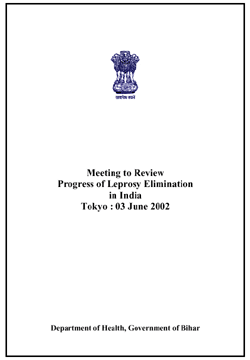|
2) Bihar
(1) Shri Shakuni Choudhary, Honorable Minister for Health of Bihar
| (拡大画面:28KB) |
 |
ADDRESS BY HON'BLE HEALTH MINISTER BIHAR
SHRI SHAKUNI CHOUDHARY
MEETING ON ACHIEVING LEPROSY ELIMINATION
TOKYO: 03 JUN 2002
Introduction
Hon'ble Minister of Govt. of India, Ministry of Health and Family Welfare Padmashree Dr. C. P. Thakur, Mr. S. K. Naik Secretary, Ministry of Health, Govi. of India, Dr. Uton Muchtar Rafei, Regional Director, WHO South East Asia Region, Mr. Yohei Sasakawa, President Sasakawa Memorial Foundation, Secretaries of the seven participating states, Heads of ILEP agencies and other distinguished participants.
I have brought greetings from my government and thank you for organizing this conference. Such conference plays an important role in the efforts to eliminate leprosy and I wish to convey to you that the state government is fully committed to the goal of leprosy elimination by March 2004.
India is one of the six countries that carry a high burden of leprosy cases. In India Leprosy was the disease associated with the coastal regions but presently the disease is endemic in other states like Jharkhand, Bihar, Uttar Pradesh, Uttranchal, Madhya Pradesh, Chattisgarh and Orissa and West Bengal. These endemic states account for 72% of the caseload of the country. If we include four more states Maharastra, Andhra Pradesh, Tamil Nadu and Karnataka, these twelve states account for 93% of the burden of leprosy.
It is a good news that major parts of the country except the above twelve states are having low incidence of the disease. Our battle with leprosy can therefore be focused on these twelve states for achieving the goal of Elimination of Leprosy.
Present Situation
We have come a long way in our fight against leprosy. With an India wide prevalence rate of 21.3 in 1991 we have now reached 4.3 in 2002. In Bihar we have brought down the prevalence from 52.2 in 1991 To 10.99 in 2002. The prevalence rate in eight states is as follows: -
| (i) |
Jharkhand |
- |
12.95 |
| (ii) |
Bihar |
- |
10.99 |
| (iii) |
Orissa |
- |
9.13 |
| (iv) |
Uttar Pradesh |
- |
5.04 |
| (v) |
West Bengal |
- |
4.41 |
| (vi) |
Chattisgarh |
- |
3.68 |
| (vii) |
Madhya Pradesh |
- |
2.32 |
| (viii) |
Uttranchal |
- |
2.25 |
However, the main challenge facing the endemic states is reaching the goal of less than 1 leprosy affected person per 10000 population by March 2004. This challenge is closely related to human issues like poverty, social issues relating to awareness and stigma; and demographic factors concerning high population density, low literacy, poor infrastructure and health facilities; and low utilization of existing health facilities.
To address the above concerns the Government of India and the State Governments in partnership with World Bank, WHO and ILEP have adopted the following viable strategies to deal with the disease:
(a) Decentralization of planning and implementation of programme up to Primary Health Center level.
(b) Strengthening of institutions at the State and District level like State Leprosy Control Society, District Leprosy Control Society, SSAUs (Survey Sampling and Assessment units) and District Hospitals.
(c) Integration with General Health Care Services for easy access to early diagnosis and treatment.
(d) and Campaign approaches like MLEC (Modified Leprosy Elimination Campaign), SAPEL (Special Action Plan for Elimination of Leprosy for rural areas), LEC ( Leprosy Elimination Campaign) for Urban areas (Slums and Marginalized communities) in themselves will assist in detecting the patients early and administering MDT. We need to ensure vigorous and efficient implementation of these strategies to achieve our goals within the desired time-frame.
Concerns
I would, however, like to share a few concerns that I feel the programme planners and this forum need to address:-
(a) Awareness. I am aware that Government of India is spending a large sum of money on IEC through electronic and print media. There is a need to devise more innovative strategies to reach the rural and low literacy pockets especially where there is low penetration of Radio, TV and electricity. One project on social mobilization is being tried out on pilot basis in Bihar. More such ideas need to be thought of to 'Reach the Unreached'.
(b) Another area of concern is the residual disabilities the disease causes. The patient who is disabled needs social and economic rehabilitation. International and National Organizations should come forward in a big way and provide technical, financial and managerial support to local voluntary organizations to build up the capability in these states to enable these people to be productive members of the society.
Conclusion
In conclusion I would like to say that the endemic states especially Bihar require innovative strategies and dedicated efforts by all partners to achieve the goal of leprosy elimination within the desired time-frame.
I reiterate the full commitment of my government, both at the political and administrative level for the programme and goal to Eliminate Leprosy by March 2004.
Thank you for your attention.
|